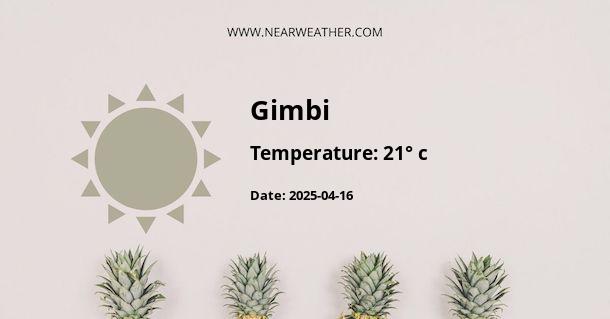Gimbi, Ethiopia: Climate and Weather Overview
Gimbi is a town located in the western part of Ethiopia, specifically in the Oromia Region. It is situated at an elevation of approximately 1,750 meters (5,740 feet) above sea level. The climate in Gimbi is classified as a tropical savanna climate, also known as a wet and dry climate. This type of climate is characterized by distinct wet and dry seasons throughout the year.
Temperature in Gimbi
The temperature in Gimbi remains relatively moderate throughout the year due to its elevation. The average annual temperature in the town is around 20 degrees Celsius (68 degrees Fahrenheit). However, there are noticeable variations in temperature between the different seasons.
During the dry season, which typically occurs from October to May, the temperature in Gimbi ranges from 18 to 25 degrees Celsius (64 to 77 degrees Fahrenheit). The hottest months are February and March, with temperatures reaching up to 25 degrees Celsius (77 degrees Fahrenheit).
On the other hand, during the wet season, which usually lasts from June to September, the temperature in Gimbi tends to be slightly cooler. The average temperature during this period ranges from 15 to 22 degrees Celsius (59 to 72 degrees Fahrenheit).
Precipitation in Gimbi
Gimbi receives a significant amount of rainfall throughout the year, with the majority of it occurring during the wet season. The town experiences a tropical monsoon climate, characterized by heavy rainfall and distinct wet and dry seasons.
During the wet season, Gimbi receives an average annual rainfall of around 1,200 millimeters (47 inches). The months of June, July, and August are the wettest, with precipitation levels reaching up to 250 millimeters (10 inches) per month.
On the contrary, the dry season experiences much less rainfall, with an average of about 50 millimeters (2 inches) per month. The driest months are usually December, January, and February.
Seasonal Variations
Gimbi experiences distinct wet and dry seasons, each with its own characteristics. The wet season, from June to September, is marked by heavy rainfall and cooler temperatures. This period is essential for agriculture and contributes to the lush green landscapes surrounding the town.
The dry season, from October to May, is characterized by lower rainfall and higher temperatures. This period is generally drier and hotter, with increased evaporation rates.
Weather Hazards
While Gimbi's climate is generally favorable, there are some weather hazards to be aware of. During the wet season, the heavy rainfall can lead to localized flooding in low-lying areas. It is important for residents and visitors to stay informed about weather updates and take necessary precautions.
Additionally, during the dry season, there is a risk of wildfires due to the drier vegetation. It is crucial to adhere to fire safety guidelines and avoid activities that may cause accidental fires.
Conclusion
Gimbi, Ethiopia, experiences a tropical savanna climate with distinct wet and dry seasons. The town enjoys moderate temperatures throughout the year, with average annual temperatures around 20 degrees Celsius (68 degrees Fahrenheit). The wet season, from June to September, brings heavy rainfall, while the dry season, from October to May, is characterized by lower precipitation levels. Understanding the climate and weather patterns of Gimbi is crucial for residents, visitors, and agricultural planning.
A - Gimbi's Latitude is 9.166670 & Longitude is 35.833328.
A - Weather in Gimbi is 21° today.
A - Climate Conditions in Gimbi shows overcast clouds today.
A - Humidity in Gimbi is 41% today.
A - Wind speed in Gimbi is 3.92 km/h, flowing at 331° wind direction. today.
